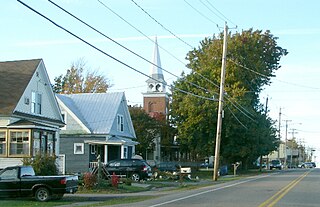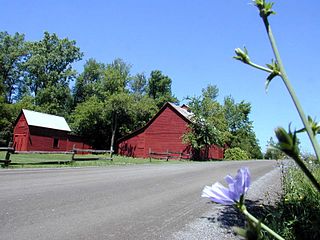
Grand Isle County is a county in the U.S. state of Vermont. As of the 2020 census, the population was 7,293, making it Vermont's second-least populous county. Its shire town is North Hero. The county was created in 1802 and organized in 1805.

Moira is a town in Franklin County, New York, United States. The population was 2,934 at the 2010 census. Moira is located on the western border of Franklin County and is west of Malone. The town was named for the Earl of Moira. The correct pronunciation of Moira is moʊ-aɪ-rʌ.

Panton is a town in Addison County, Vermont, United States. The population was 646 at the 2020 census.

Shoreham is a town in Addison County, Vermont, United States. The population was 1,260 at the 2020 census.

Colchester is a town in Chittenden County, Vermont, United States. As of the 2020 census, the population of Colchester was 17,524. It is the third-most populous municipality and most populous town in the state of Vermont. Colchester borders Burlington, Vermont's most populous municipality. The town is directly to Burlington's north on the eastern shore of Lake Champlain, to the west of the Green Mountains. The Vermont National Guard is based in the town, and it is also home to Saint Michael's College and the Vermont campus of Southern New Hampshire University.

Canaan is a town in Essex County, Vermont, United States. The population was 896 at the 2020 census. Canaan contains the village of Beecher Falls, located at the confluence of the Connecticut River and Halls Stream. It is part of the Berlin, NH–VT Micropolitan Statistical Area.

Fairfax is a town in Franklin County, Vermont, United States. The population was 5,014 at the 2020 census.

Franklin is a town in Franklin County, Vermont, United States. The population was 1,363 at the 2020 census. The original name was "Huntsburgh", but the name was changed to "Franklin" in 1817.

Georgia is a town in Franklin County, Vermont, United States. The population was 4,845 at the 2020 census.

Highgate is a town in Franklin County, Vermont, United States. The population was 3,472 at the 2020 census. The town is on the Canada–US border and is a border town with Philipsburg, Quebec.

Grand Isle is a town on Grand Isle in Grand Isle County, Vermont, United States. The population was 2,086 at the 2020 census.

Isle La Motte is an island in Lake Champlain in northwestern Vermont, United States. At 7 mi (11 km) by 2 mi (3 km), it lies close to the place that the lake empties into the Richelieu River. It is incorporated as a New England town in Grand Isle County. Its population was 488 at the 2020 census.

North Hero is a town in and the shire town of Grand Isle County, Vermont, United States. The population was 939 at the 2020 census.

South Hero is a town on Grand Isle in Grand Isle County, Vermont, United States. South Hero's population was 1,674 at the 2020 census.

Champlain is a town in Clinton County, New York, United States. The population was 5,754 at the 2010 census. The town is located on the western shore of Lake Champlain, near the northern end of Lake Champlain and is on the U.S./Canadian border.

Saint Albans, commonly abbreviated as St. Albans, is a town in Franklin County, Vermont, United States. As of the 2020 census, the population was 6,988. The town completely surrounds St. Albans City, which is a separate municipality.

Swanton is a village in the town of Swanton in Franklin County, Vermont, United States. It is sometimes called Swanton Village to distinguish it from the surrounding town of the same name. The population was 2,328 at the 2020 census. It was founded in 1888.

Swanton is a town in Franklin County, Vermont, United States. The population was 6,701 at the 2020 census. The town includes the village of Swanton.

Alburgh is a village within the town of the same name in Grand Isle County, Vermont, United States. The population was 571 at the 2020 census. The town's name came from the person primarily responsible for chartering the community, Ira Allen.

Cambridge is a town in Lamoille County, Vermont, United States. The population was 3,839 at the 2020 United States Census. Cambridge includes the villages of Jeffersonville and Cambridge.

























